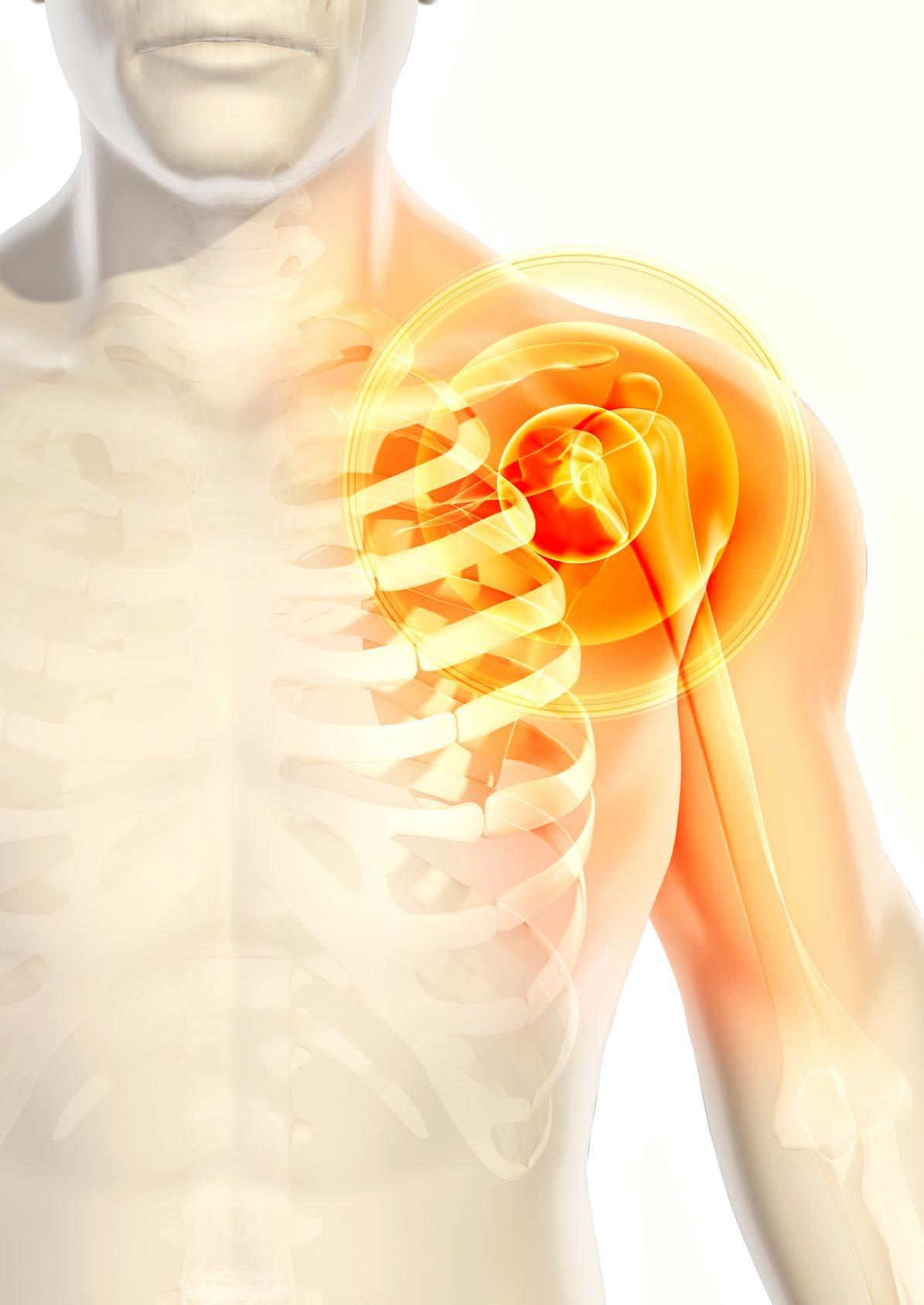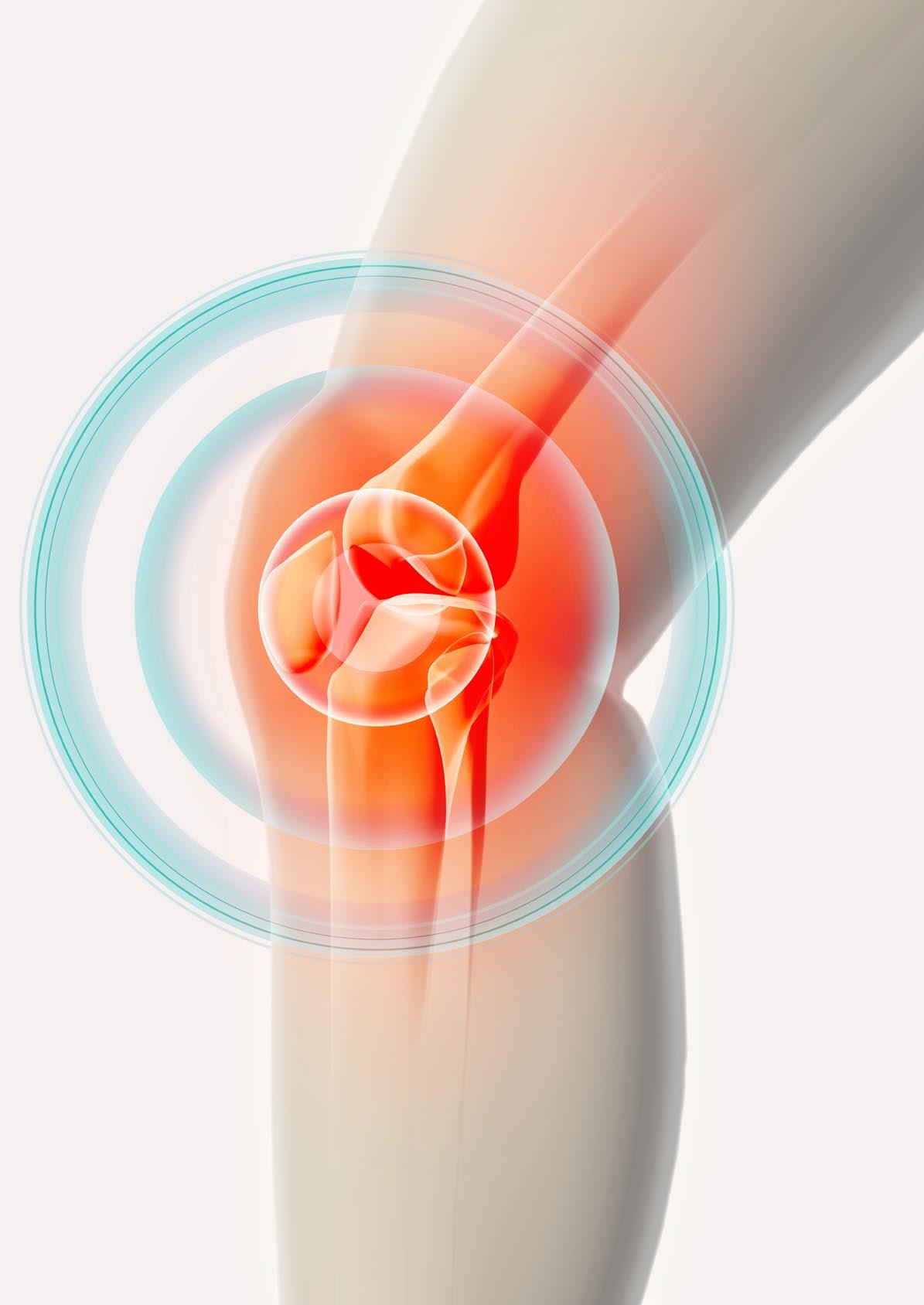
21 minute read
Power Words when dealing with Chronic Pain
The use of Power Words when dealing with Chronic Pain
Keywords: Chronic pain, Communication, Quality of Life, Hypnosis, Powerful Words
Advertisement
ABSTRACT What do the pain clinics and the sales business industry have in common? The answer to this is attention and engagement during a conversation. Hypnosis has taught us throughout the years that this type of inexpensive, non-pharmacological intervention and safe procedure can be used in clinics to engage better with the patient. The use of the first stage of hypnosis is particularly relevant, more specifically the use of power words which can help achieve better and more effective communication, leaving an empowered client.
1. INTRODUCTION 20% of the adult population in Europe are affected by chronic pain.1 This means that one in five Europeans suffers from pain that has been present for more than 3 months. Chronic pain adds up to 1.5 billion adults’ worldwide.2 The most important factor of these figures is that pain has an impact on the quality of life of the individual.
Pain is one of the leading causes of years lived with disability according to the Global Burden of disease in 2017.3 Consequently pain is not only an individual problem but also a hurdle to the health care systems and the economy. This burden to the patient and society costs up to $635 billion in the US 4 and €441 billion in Europe as stated by the Societal Impact of Pain.5 These costs are greater than that of heart disease, cancer or diabetes.3
Pain, chronic pain in particular, is a very subjective symptom. Its complexity is since pain experience can be perceived and managed differently by each individual. Anxiety and stress usually co-exist with chronic pain which will increase sensitization to pain in certain areas of the brain, as well as increase cholecystokinin in blood which will act as an opiate antagonist. Further to this, stress hormones shuts down the dopamine systems which is the reward pathway.6,7 Effective communication has always been of the utmost importance between a patient and the evaluating and managing pain physician. In keeping with this, having good communication skills helps in eliciting effective pain history and subsequent assessment leading to an accurate diagnosis and ultimately a patient-centred approach in a realistic treatment and management plan.8 This will ultimately help in reducing pain, empowering and motivating patients, resulting in better quality of life.
2. HYPNOSIS Hypnosis, also known as hypnotherapy, is a type of alternative non-pharmacological medicine that can alter the consciousness by suggestion. It was James Braid, a Scottish neurosurgeon, in the late 1800’s that invented the word hypnosis from the Greek word ‘Hypnos’ meaning sleep. He is considered as the first hypnotherapist. This type of therapy has flourished over the past two decades and is now a well-established treatment for managing pain in the adult population.9 It has been defined as a state of attentive and receptive concentration generating changes in individuals’ experiences of themselves and their environment.10,11
Hypnosis usually, but not always, involves relaxation methods.14 It allows the individual to move into the unconsciousness and alter any mental impairment and function better in the conscious state. The theory behind this therapy is confirmed with neuroimaging studies in adults undergoing hypnosis. These studies have shown that during hypnotic experiences significant changes associated with sensory and perception of pain are involved, namely the somatosensory cortex, thalamus and insula as well as the supplementary motor cortex.13-15
The use of hypnosis has been increasingly used in multidisciplinary pain management. Studies have shown that hypnosis helped alleviate pain and anxiety before, during and after surgical procedures, both invasive and non-invasive.11,12
2.1 Hypnosis and Chronic pain The interest in the use of hypnosis in treating chronic pain is currently increasing. An increasing number of studies have been published with confirms that hypnosis can help in managing chronic pain more safely with less side-effects than pharmacological and interventional treatments. Hypnosis in chronic pain starts with a hypnotic induction which proposes relaxation. This is followed by post-hypnotic suggestions including targeted verbal ideas that will help alleviate pain even after the session. Teaching the patient self-hypnosis can also help the patient in daily pain reduction.
The largest meta-analysis to date investigating the effectiveness of hypnosis as a technique for reducing pain was published by Thompson et al. (2019) which gathered evidence from 85 controlled studies worldwide, from 1970 till 2017 consisting of 3632 participants (hypnosis n=2,892, control n= 2,646, with crossover trials primarily used).18 This meta-analysis aimed to quantify the effectiveness of hypnosis for reducing pain and identify factors that influence efficacy. Trials were systematically searched comparing hypnotic inductions with no-intervention control conditions in relation to pain ratings, threshold and tolerance. 3632 participants were analysed. Pain relief was strongly influenced by the use of direct analgesic suggestion as well as hypnotic suggestibility. These findings suggest that hypnotic intervention can deliver meaningful pain relief for high and medium suggestibles and therefore may be an is done once, it is easier to do it again as this would have switching on their imagination one can sense the feeling of
effective and safe alternative to pharmaceutical intervention. Overall, the findings that hypnotic induction resulted in a reliable decrease in experimentally-induced pain suggest that hypnosis may represent a potentially effective and safe alternative or adjunct to pharmacological intervention for acute pain.18
2.2 The 4 stages of hypnosis James Braid, in the 1800’s describes the 4 basic rules required for a patient to reach a subconscious stage where one is able to alter the conscious mind as shown in table 1.
2.3 How can we use the first stage of hypnosis to achieve better communication? The use of power words are an integral part in the first stage of hypnosis. These will unknowingly captivate the patient’s attention. These words especially though repetition will make the patient feel empowered. Although these powerful words may sound natural in everyday use, such words, when used in the correct environment and at the appropriate time, will help the clinician to engage better with the patient and also, in this first stage, the patient will be able to express himself and understand the facts more effectively.
Obviously, this can vary from one individual to we communicate verbally that can allow us to envisage typical actions.
The knowledge of powerful words and their use in the correct setting is a skill which can be learnt. These are used frequently in the sales industry and are taught to representatives to market their product i.e. engaging with potential clients’.

3. POWERFUL WORDS “Imagine if communication with patients is more successful. And you can remember a time when it was natural to get a message across the patient without any problems. This is because you already know how…”
I have already used five power words to keep you reading.
These five powerful words that any individual can be associated with and trigger certain behaviour are the following:
3.1 ‘Imagine’ The word imagine immediately switches on imagination in an individual in which everything is possible in the subconscious mind. The use of their imagination helps explore options, limits and possibilities that they could have never considered before in reality. If this vivid imagination been also memorised too. This is an outstanding way of getting through resistances that occurred in the past and are memorized. Vivid imagination and reality is something that the brain can little differentiate between, so by actually another but there are observable patterns in the way
being there and start exploring any answers or sensations. This allows us to be much more open to new ideas and lowers our guard.
3.2 ‘And’ The word ‘and’ automatically connects two ideas, that do not have to be related but will create a cause and effect situation or imply similarity. By linking these ideas, the first concept would be accepted more easily, and the second concept is likely to be received in a favourable way too. An example of such case would be: ‘We can do physiotherapy and injections for this type of pain to improve’.
3.3 ‘You’ ‘You’ or ‘yours’ immediately gets the individual’s attention and directly activates the subconscious; which is where most of our decisions are made. This is even more empowered
Table 1: The 4 stages of hypnosis and their significance
Stage 1 - Absorb attention
Stage 2 - Bypassing the Critical Faculty Stage 3 - Activate an unconscious response Stage 4 - Leading the unconscious to desired outcome Attention and focus are captured by speaking and engaging with the patient.
Critical Faculty is the area of the brain used for reasoning and logic.
Unconscious responses are activated leading to a hypnotic state.
Once all 3 states have been surpassed, the hypnotherapist is able to use hypnotic suggestions, in the form of commands and metaphors.
by using their own name, but it should not be exhausted and over-used since it may be interpreted as deceitful. Our name is the most familiar sound we have ever heard and it is acceptable, prior to the start of the session, for the hypnotist to ask how it is pronounced and then use it during the hypnosis to communicate effectively. This creates a very personal connection, based on trust and perceived environmental familiarity, which will ultimately raise the level of interest, becoming more open to shared ideas.
3.4 ‘Remember’ Reminiscing events from the past can make an individual able to remember events. If these are positive ones one can embrace and recall positive feelings such as love, friendship and enjoyable events that may help the individual reconnect with the positive moment. This may positively enhance their mood and then remove any negative feelings. You are not asking the individual to do anything, but you are asking them to remember and move to other situations where they have been more resourceful. An example is, ‘Remember how much fun you had with your friends when you attended that meal?’ Obviously, these statements would have been corroborated before the session.
3.5 ‘Because’ ‘Because’ is a word where one is implying that there will be an explanation that follows. The reason that follows the ‘because’ should be brief, quick to respond and will work best for small requests or suggestions. Larger requests may not be able to surpass the critical factor in the brain and may not be accepted. An example of such case would be: ‘weight loss in your case is ideal in treating back pain because there is arthropathy of the facet joints’ instead of just saying ‘you should lose weight.’
If no reason is suggested or even worse the over-used parentalistic statement ‘because that what’s needs to be done’ will immediately shut the individual from listening and involving more in the conversation.
Example: taking these medications will help you sleep better because you have a sleeping problem’ instead of saying ‘Take this treatment because that what’s needs to be done’.
When this lacks in communication, the individual will start looking for reasons and this will ultimately lead to more resistance. Therefore, by using the word ‘because’ followed by a reason, this will immediately fill that gap and the individual will recognise that reason and is able to take subsequent action.

4. CONCLUSION Increasing concern over the side-effects, addictive properties and costs of opioid medication has led to an urgent need to identify non-pharmacological interventions for pain that are effective and safe. Hypnosis has confirmed that there is a place for this well-established integrative, inexpensive, non-pharmacological intervention for chronic pain management in adults; there is also a growing research interest in the management of chronic pain in the paediatric population.19,20
Hypnosis can change the way how individuals behave and think. By altering very little one can achieve great results and the use of powerful words will ultimately help in becoming a better communicator. Communication starts by building trust your product (in the case of selling items) or services (in clinics)
DISCLOSURES There are no conflicts of interest to declare.
REFERENCES
1.
2.
3.
4.
5. 6.
7.
8.
9.
10.
11.
12.
13.
14.
15.
16.
17.
18.
19.
20. Breivik H, Collett B, Ventafridda V, Cohen R, Gallacher D. Survey of chronic pain in Europe: prevalence, impact on daily life, and treatment. Eur J Pain. 2006;10(4):287-333. doi:10.1016/j. ejpain.2005.06.009 Yaqub, F., 2015. Pain in the USA: states of suffering. Lancet 386 (9996), 839 Collaborators, G.B.D.C.O.D, 2017. Global, regional, and national age-sex specific mortality for 264 causes of death, 1980-2016: a systematic analysis for the Global Burden of Disease Study 2016. Lancet 390 (10100), 1151–1210. Gaskin, D.J., Richard, P., 2012. The economic costs of pain in the United States. J. Pain 13 (8), 715–724 Society Impact of Pain Annual Symposium 2017, Malta Benedetti F, Lanotte M, Lopiano L, Colloca L: When words are painful: unravelling the mechanism s of the Nocebo effect. Neuroscience 2007; 147:260-271. Jensen M : Hypnosis for chronic pain management: A new hope. Pain 2009; 146: 235- 237. Taylor K. Paternalism, participation and partnership – the evolution of patient centeredness in the consultation. Patient Educ Couns 2009;74:150–5. Adachi, T.; Fujino, H.; Nakae, A.; Mashimo, T.; Sasaki, J. A metaanalysis of hypnosis for chronic pain problems: A comparison between hypnosis, standard care, and other psychological interventions. Int. J. Clin. Exp. Hypn. 2014, 62, 1–28. Hilgard, E.R. Hypnotic Susceptibility; Harcourt, Brace & World Inc.: New York, NY, USA, 1965. Spiegel, H.; Spiegel, D. Trance and Treatment: Clinical Uses of Hypnosis; American Psychistric Publishing:Washington, DC, USA, 1987; ISBN 978-1585621903 Amraoui J, Pouliquen C, Fraisse J, et al. Effects of a Hypnosis Session Before General Anesthesia on Postoperative Outcomes in Patients Who Underwent Minor Breast Cancer Surgery: The HYPNOSEIN Randomized Clinical Trial. JAMA Netw Open. 2018;1(4):e181164. Lobe, T.E. Perioperative hypnosis reduces hospitalization in patients undergoing the Nuss procedure for pectus excavatum. J. Laparoendosc. Adv. Surg. Tech. A 2006, 16, 639–642 Jensen, M. P., & Patterson, D. R. (2014). Hypnotic approaches for chronic pain management: Clinical implications of recent research findings. American Psychologist, 69(2), 167-177 Crawford, H.J.; Horton, J.E.; Harrington, G.C.; Vendemia, J.M.C.; Plantec, M.B.; Jung, S.; Shamro, C.; Downs, J.H., III. Hypnotic analgesia (Disattending pain) impacts neuronal network activation: An fMRI study of noxious somatosensory TENS stimuli. Neuroimage 1998, 7, S436. Rainville, P.; Duncan, G.H.; Price, D.D.; Carrier, B.; Bushnell, M.C. Pain affect encoded in human anterior cingulate but not somatosensory cortex. Science 1997, 277, 968–971. Chambless, D.L.; Hollon, S.D. Defining empirically supported therapies. J. Consult. Clin. Psychol. 1998, 66, 7–18. Trevor Thompsona, Devin B. Terhuneb , Charlotte Orama , Joseph Sharangparnia , Rommana Roufa , Marco Solmic , Nicola Veronesed , Brendon Stubbs. The effectiveness of hypnosis for pain relief: A systematic review and metaanalysis of 85 controlled experimental trials. Neuroscience & Biobehavioral Reviews, 2019, 99, 298-310 Montgomery, G.H.; DuHamel, K.N.; Redd, W.H. A meta-analysis of hypnotically induced analgesia: How effective is hypnosis? Int. J. Clin. Exp. Hypn. 2000, 48, 138–153. Liossi, C.; Hatira, P. Clinical hypnosis versus cognitive behavioral training for pain management with pediatric cancer patients undergoing bone marrow aspirations. Int. J. Clin. Exp. Hypn. 1999, 47, 104–116.
DUAC (CLINDAMYCIN/BENZOYL PEROXIDE) IS AN EFFECTIVE TREATMENT THAT HELPS YOUR MILD TO MODERATE ACNE PATIENTS TO SEE IMPROVEMENTS FAST1,3
DUAC HAS A DUAL MODE OF ACTION2
Benzoyl Peroxide Clindamycin
Keratolytic2

Treats comedones2 and infl ammatory lesions5
Bactericidal action against P. acnes strains2 Suppresses P. acnes 2

Anti-infl ammatory action5
Duac:2 Unblocks follicles Reduces infl ammation Kills bacteria Reduces the potential for bacterial resistance

DUAC UNDERSTANDS WHAT’S IMPORTANT TO PATIENTS
Duac works fast, starting to work in just 2 weeks3 Duac is a once daily treatment2 Duac is generally well-tolerated2,5

Most common side eff ects include erythema, peeling, dryness, burning sensation, photosensitivity and headache
DUAC INDICATIONS & USAGE ADVICE2
Duac Once Daily Gel is indicated for the topical treatment of mild to moderate acne vulgaris, particularly infl ammatory lesions in adults and adolescents from 12 years of age and above2 Formulation contains added moisturisers, glycerin and dimethicone, for better tolerability1
YOUR EXPERT ADVICE CAN SHOW ON THEIR FACE
Duac comes ready-mixed, and is easy for your patients to use. It is recommended that you off er the following guidance4: Once-daily, in the evening, your patients should2:
Thoroughly wash the aff ected area of skin Gently pat dry Apply a thin layer of Duac gel on the aff ected area, not just the individual spots
TIPS4
If your patient’s skin peels or becomes dry, they can try: Using an oil and fragrance-free hypoallergenic moisturiser Using Duac less often, or stopping for one or two days before starting again
DUAC ONCE DAILY GEL 10mg/g + 50mg/g ABRIDGED PRESCRIBING INFORMATION
Please refer to the full Summary of Product Characteristics (SPC) before prescribing TRADE NAME: Duac Once Daily Gel 10mg/g + 50mg/g. ACTIVE INGREDIENTS: Clindamycin phosphate/anhydrous benzoyl peroxide. PHARMACEUTICAL FORM: Gel. INDICATIONS: Topical treatment of mild to moderate acne vulgaris, particularly inflammatory lesions in adults and adolescents from 12 years of age and above. POSOLOGY: Adults and Adolescents (12 years and over): Once daily (evening) to affected area. Should not exceed more than 12 weeks. Applied in a thin film after washing gently with mild cleanser and fully drying. Was hands after application. CONTRAINDICATIONS: Hypersensitivity to active substances/lincomycin/excipients. PRECAUTIONS: Avoid Contact with the mouth, eyes, lips, other mucous membranes or areas of irritated/broken skin. Caution in patients with a history of regional enteritis, ulcerative colitis, antibiotic-associated colitis, atopic patients, concomitant topical acne therapy. Increase in peeling and reddening will occur in most patients during first few weeks of treatment. If severe local irritancy, discontinue. Prolonged exposure to sun should be avoided. In patients with sunburn, this should be resolved before use. If significant diarrhoea/abdominal cramps occur, discontinue (symptoms may indicate antibiotic-associated colitis). May bleach hair or coloured fabrics. Patients with a recent history of systemic or topical clindaymcin and erythromycin are more likely to have pre-existing anti-microbial resistant Propionibacterium acnes and commensal flora. Crossresistance: May occur when using antibiotic monotherapy. PREGNANCY /FERTILITY / LACTATION: Pregnancy: only after careful risk/benefit assessment. Fertility: no data. Lactation: should not be applied to breast area. UNDESIRABLE EFFECTS: Very common (≥1/10): erythema, peeling, dryness. Common (≥1/100 & <1/10): burning sensation. Refer to the SPC for full list of undesirable effects. LOCAL PRESENTATION: 30g gel. MARKETING AUTHORISATION NUMBER: MA192/02801. MARKETING AUTHORISATION HOLDER: GlaxoSmithKline (Ireland) Ltd. Legal Category: POM. Date of Preparation: May 2019.
For the latest product information, please refer to the full SPC available from: gskpro.com/en-mt/ products or contact us at GSK Malta (phone: +35621238131).
Trademarks are owned by or licensed to the GSK group of companies.
REPORTING ADVERSE EVENTS (AEs):
Suspected adverse events should be reported to GSK Malta through: gskpro.com/en-mt (Phone: +356212381311, Address: GSK Malta, 1 (1st floor), de la Cruz Avenue, Qormi, Malta). Malta: Cases may also be reported through medicinesauthority.gov.mt/adrportal (Malta Medicines Authority)
References: 1. Langner A et al. BJD 2008; 158: 122–129. 2. Duac 5% Summary of Product Characteristics March 2019. 3. Langner A et al. JEADV 2007; 21: 311-319. 4. Duac 5% Patient Information Leaflet, March 2019. 5. Lookingbill DP et al. JAAD 1997; 37: 590-595.




BRINTELLIX ABRIDGED PRESCRIBING INFORMATION




Please refer to the full Summary of Product Characteristics (SPC) before prescribing, particularly in relation to side effects, precautions and contraindications. P Preres se en nt ta at tioion n: : Tablets containing 5, 10 or 20mg of vortioxetine (as the hydrobromide). Indications: Treatment of major depressive episodes in adults. Dosage: 10mg once daily. Dose may be increased to a maximum of 20mg daily or reduced to 5mg if necessary. After depressive symptoms resolve, treatment for at least 6 months is recommended. Elderly (≥65 years): Initial dosage is 5mg once daily. Caution advised if using doses above 10mg daily as data are limited. Children and adolescents (<18 years): Not recommended as safety and efficacy not established. Cytochrome P450 inhibitors and inducers: Consider a dose reduction of vortioxetine if a strong CYP2D6 inhibitor is added. Consider a dose adjustmentadjustment if a broad CYP450 inducer is added to treatment. Renal and Hepatic impairment: Given that subjects with renal or hepatic impairment are vulnerable and given that the data on the use of Brintellix in these subpopulations are limited, caution should be exercised when treating these patients. Contraindications: Hypersensitivity to the active substance or any of the excipients. Concomitant use with non-selective, monoamine oxidase inhibitors (MAOIs) or selective MAO-A inhibitors (e.g. moclobemide). Fertility, pregnancy and lalac ctatation:tion: Do not use in pregnancy unless clinically necessary. Limited data on the use of vortioxetine in pregnant women. Animal studies have shown reproductive toxicity. Use of SSRIs in pregnancy, particularly in late pregnancy, may increase the risk of persistent pulmonary hypertension in the newborn (PPHN). It is expected that vortioxetine will be excreted into human milk, and a risk to the suckling child cannot be excluded. Fertility: Animal data showed no effect on fertility, sperm quality or mating performance. Human case reports with s so omeme SSRIs have shown that an effect on spermquality is reversible. Impact on human fertility has not been observed so far. Precautions: Use caution when driving a car or operating machinery. Closely supervise patients, especially those at high risk, for suicide-related behaviours during first few weeks of treatment and during dose changes. Use with caution in patients: at risk of hyponatraemia; with a history of mania/hypomania; undergoing ECT; with unstable epilepsy (discontinue if seizures begin for the first time or increase in frequency); wiwithth bleeding tendencies/disorders, taking anticoagulants or medicines affecting platelet function; in patients on lithium or tryptophan. Monitor patients for appearance of serotonin syndrome or neuroleptic malignant syndrome and discontinue if occurs. Adverse events: Adverse reactions were usually mild or moderate, transient and occurred within the first two weeks of treatment. The following adverse events were reported: Very common (>1/10 patients); nausea. Common (>1/100 <1/10); abnormal dreams, dizziness, diarrhoea, constipation, vomiting, pruritis, including generalised pruritis. Prescribers should consult the full SPC in relation to other side effects.
Legal Category: POM. Local Presentation: 28 tablet pack: 5mg, 10mg, 20mg. Marketing Authorisation Holder: H.Lundbeck A/S, Ottiliavej 9, 2500 Valby, Denmark. Marketing Authorisation Number: 5mg EU/1/13/891/002, 10mg EU/1/13/891/010, 20mg EU/1/13/891/028
Full prescribing information is available on request from the local representative agent of Lundbeck in Malta: Charles de Giorgio Ltd. Triq Kan. K. Pirotta B’Kara, BKR 1114 Malta. Tel: +356 25600 500
Date of preparation: April 2020

The Role of Pharmacy Students during the COVID-19 pandemic

Pharmacy and Pharmaceutical Technology students from the Department of Pharmacy at the University of Malta were involved in several activities during the COVID-19 pandemic in Malta. During such a time, students are encouraged to engage in healthcare activities, in preparation for their professional life. Students were particularly involved in two main activities which required manpower.
Students were invited by the Pharmacy of Your Choice Unit to assist with the +70 Domiciliary Delivery Service. Their task was to deliver medicines to older and vulnerable persons who were encouraged by the health authorities to stay at home. Together with the Local Enforcement System Agency, students delivered POYC medicines to these persons’ doorstep. The responsibility of the students was to deliver the right medicines to the respective patient. This was a win-win situation to both Pharmacy students and patients. Such an activity enhanced the relationship between the future healthcare professionals and the patients and at the same time decreased the patients’ need to visit healthcare centres or community pharmacies.
Pharmacy and Pharmaceutical Technology students were also invited to prepare hand rub sanitisers at the Pathology Department of Mater Dei Hospital in collaboration with the Central Procurement and Supplies Unit. This, in view of the fact that demand for hand rubs by healthcare workers increased during the pandemic.
Although Pharmacy students practise at community pharmacies as part of their training, some students increased their presence at this time of need. As frontliners, this was very challenging. Apart from assisting the pharmacist, they were also involved in educating the patient. Students explained to patients the correct way how to apply hand sanitisers, how to wear masks properly, and how to practise social distancing amongst others.
During this time, students continued following on-line lectures and working on their assignments. Like all other students at the University, they faced the uncertainties related to the examination period.
Although the situation is not yet over, pharmacy students are still aware of the potential re-emergence of the virus. For the time being the situation has eased, however, pharmacy students are there on-call.







